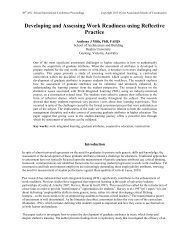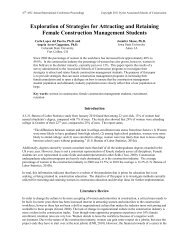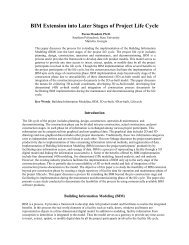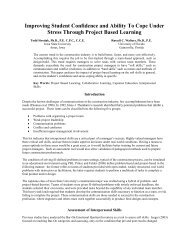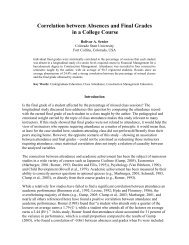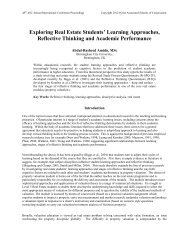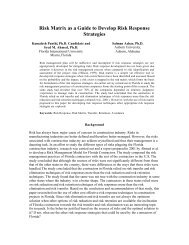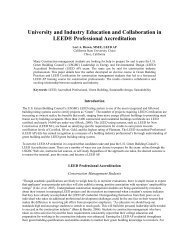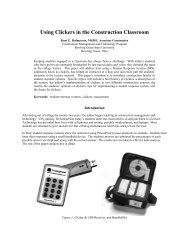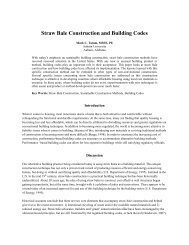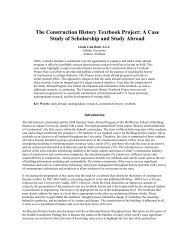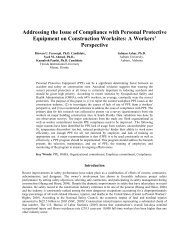What Are the Most Important Issues of Storm Water Pollution ...
What Are the Most Important Issues of Storm Water Pollution ...
What Are the Most Important Issues of Storm Water Pollution ...
You also want an ePaper? Increase the reach of your titles
YUMPU automatically turns print PDFs into web optimized ePapers that Google loves.
<strong>What</strong> <strong>Are</strong> <strong>the</strong> <strong>Most</strong> <strong>Important</strong> <strong>Issues</strong> <strong>of</strong> <strong>Storm</strong> <strong>Water</strong><br />
<strong>Pollution</strong> Prevention Planning for Construction Graduates<br />
to Know<br />
Natasha W. McCurry, MBC and Philip Irgens, MBC<br />
Auburn University<br />
Auburn, AL<br />
Having an approved storm water pollution prevention plan (SWPPP) on a construction jobsite is a<br />
necessity in today’s construction industry. A contractor must have a SWPPP or risk possible<br />
catastrophic environmental contaminations, and more importantly in today’s business world, very<br />
costly monetary fines and possibly even prison time for all parties involved in <strong>the</strong> violations. The<br />
purpose <strong>of</strong> this paper is to determine what graduating students <strong>of</strong> Auburn University’s Building<br />
Science program need to know about SWPPP. The current curriculum in <strong>the</strong> program has no<br />
lecture module or information regarding SWPPP being taught to students. The result <strong>of</strong> this study<br />
will provide <strong>the</strong> baseline data for determining what information is most important for incoming<br />
employees to <strong>the</strong> construction industry, based on interviews and surveys <strong>of</strong> industry pr<strong>of</strong>essionals<br />
as well as feedback from o<strong>the</strong>r academics.<br />
Keywords: Soils, Earthwork, Sediment Control, Erosion Control, Sustainability<br />
Introduction<br />
In recent years, public demand for environmental consciousness has continued to thrive as can be<br />
witnessed in <strong>the</strong> emergence <strong>of</strong> Leadership in Energy and Environmental Design (LEED) –<br />
America’s most widely recognized performance benchmark for environmentally friendly<br />
construction projects. Likewise, as <strong>the</strong> environmental concerns have become more significant,<br />
<strong>the</strong> laws and regulations have become more stringent, increasing demands on contractors with<br />
respect to sitework – specifically erosion and sediment control. In fact, one <strong>of</strong> <strong>the</strong> prerequisites<br />
for achieving any points in <strong>the</strong> Sustainable Sites portion <strong>of</strong> <strong>the</strong> LEED rating system is<br />
maintaining a good best management practices erosion and sediment control program for<br />
projects pursuing certification. In an effort to integrate sustainable practices into <strong>the</strong> Soils class<br />
at Auburn University, as well as to respond to <strong>the</strong> Industry Advisory Council’s request to<br />
integrate erosion and sediment control topics into <strong>the</strong> existing curriculum, <strong>the</strong> authors have<br />
solicited responses from <strong>the</strong> industry pr<strong>of</strong>essionals who regularly deal with this matter in an<br />
effort to determine exactly what construction students need to know upon graduating from <strong>the</strong><br />
Building Science program at Auburn University. The authors have also contacted o<strong>the</strong>r<br />
construction education programs in an effort to determine related approaches.<br />
Literature Review<br />
Public outcry <strong>of</strong> concerns about <strong>the</strong> unregulated procedures within industries causing pollution<br />
and damage to <strong>the</strong> world’s environment and <strong>the</strong> United States water supply caused <strong>the</strong> U.S.<br />
Congress to create and enact <strong>the</strong> National Environmental Protection Act <strong>of</strong> 1969. The act has<br />
many purposes; one being to declare a national policy which will encourage productive and
enjoyable harmony between man and <strong>the</strong> environment. O<strong>the</strong>r purposes <strong>of</strong> <strong>the</strong> National<br />
Environmental Protection Act <strong>of</strong> 1969 were to promote efforts which will prevent or eliminate<br />
damage done to <strong>the</strong> environment and all <strong>of</strong> its inhabitants and to enrich <strong>the</strong> understanding <strong>of</strong> <strong>the</strong><br />
ecological systems and natural resources important to <strong>the</strong> world. To monitor <strong>the</strong>se efforts, <strong>the</strong><br />
U.S. congress established <strong>the</strong> Environmental Protection Agency (EPA). The National<br />
Environmental Protection Act <strong>of</strong> 1969 established <strong>the</strong> Council on Environmental Quality as well.<br />
The National Environmental Protection Act <strong>of</strong> 1969 also brought about <strong>the</strong> creation <strong>of</strong> <strong>the</strong> Clean<br />
<strong>Water</strong> Act <strong>of</strong> 1972 which still governs pollution laws today. (EPA, 2006)<br />
The first target <strong>of</strong> <strong>the</strong> Clean <strong>Water</strong> Act <strong>of</strong> 1972 was large industries and wastewater treatment<br />
plants that were dumping pollutants and raw sewage directly into waterways <strong>of</strong> <strong>the</strong> United<br />
States. According to EPA statistics, industries and wastewater treatment plants were responsible<br />
for just 40% <strong>of</strong> <strong>the</strong> pollution entering U.S. waterways. The majority <strong>of</strong> <strong>the</strong> rest <strong>of</strong> pollution<br />
comes from <strong>the</strong> various activities <strong>of</strong> <strong>the</strong> construction industry. As a result, in 1987 <strong>the</strong> EPA<br />
narrowed its focus even more and started monitoring large construction activities that disturbed<br />
more than five acres <strong>of</strong> land. (National <strong>Storm</strong> <strong>Water</strong> Summit, 2006) The revision <strong>of</strong> focus was<br />
called Phase I <strong>of</strong> <strong>the</strong> National <strong>Pollution</strong> Discharge Elimination System (NPDES) under <strong>the</strong> Clean<br />
<strong>Water</strong> Act. In 1990, <strong>the</strong> EPA began requiring any construction activity that disturbed more than<br />
five acres <strong>of</strong> land to acquire an NPDES permit.<br />
The EPA narrowed its focus even fur<strong>the</strong>r in 2003 by establishing Phase II <strong>of</strong> <strong>the</strong> NPDES.<br />
Construction activities, including many o<strong>the</strong>r land-disturbing activities that affect one acre or<br />
more <strong>of</strong> land are now required to obtain an NPDES permit as well, with an approved SWPPP.<br />
(NPDES, 1999) NPDES Phase II regulations regarding storm water management on<br />
construction jobsites are still under <strong>the</strong> umbrella <strong>of</strong> <strong>the</strong> Clean <strong>Water</strong> Act. On March 10, 2003,<br />
new regulations came into effect that extended coverage to construction sites that disturb one<br />
acre or more <strong>of</strong> land, including smaller sites that are part <strong>of</strong> a larger common plan <strong>of</strong><br />
development or sale. Only sites disturbing five acres or more were regulated previously. (EPA,<br />
2006)<br />
One <strong>of</strong> <strong>the</strong> main harmful consequences to <strong>the</strong> environment caused by construction is due to<br />
contractors who have improperly implemented <strong>the</strong>ir SWPPPs and allowed uncontrolled run<strong>of</strong>f <strong>of</strong><br />
silt and sediment from <strong>the</strong>ir jobsites. The run<strong>of</strong>f that comes from construction jobsites can carry<br />
harmful contaminants into <strong>the</strong> water supply, polluting <strong>the</strong> public drinking supply, or risking <strong>the</strong><br />
existence <strong>of</strong> certain endangered species <strong>of</strong> animals in fragile ecosystems. Run<strong>of</strong>f also causes<br />
problems by transporting loose alluvial top soils down flood plains and into city drainage<br />
systems creating increased costs <strong>of</strong> monitoring and maintenance for local municipalities.<br />
(Schroeder, 2004)<br />
In addition to <strong>the</strong> environmental consequences, <strong>the</strong> legal ramifications that can be placed on <strong>the</strong><br />
contractor responsible for improper storm water management can be quite severe. The Clean<br />
<strong>Water</strong> Act makes it illegal for any person or business to discharge any pollutant liquid, solid or<br />
o<strong>the</strong>rwise unless a permit for such a discharge is issued under <strong>the</strong> Clean <strong>Water</strong> Act. If a person<br />
or business is found guilty <strong>of</strong> violating any <strong>of</strong> <strong>the</strong> terms set forth by <strong>the</strong> Clean <strong>Water</strong> Act, <strong>the</strong>y<br />
can face both civil and criminal penalties. The civil penalties from <strong>the</strong> Clean <strong>Water</strong> Act can be<br />
up to $25,000 per day until <strong>the</strong> violation is alleviated. The criminal penalties can also be up to
$25,000 per day; but may also assess an additional penalty <strong>of</strong> up to one year in prison. (Kelleher,<br />
2005)<br />
The first step that a contractor must take in order to prevent any possible violations is to apply<br />
for a general construction permit with <strong>the</strong> EPA. However, <strong>the</strong> EPA’s general permit does not<br />
apply in all states. Some states have <strong>the</strong>ir own versions <strong>of</strong> general construction permits, but<br />
<strong>the</strong>se state versions must meet or exceed <strong>the</strong> limits set forth by <strong>the</strong> original EPA’s general<br />
construction permit. (Kelleher, 2005) The process <strong>of</strong> getting approved for <strong>the</strong> EPA’s general<br />
construction permit is for <strong>the</strong> entity in control <strong>of</strong> <strong>the</strong> jobsite to establish a SWPPP that is specific<br />
to each jobsite and to file a “Notice <strong>of</strong> Intent” with <strong>the</strong> EPA. In order for <strong>the</strong> jobsite specific<br />
erosion and sediment control plan to meet <strong>the</strong> EPA or individual state standards, it must include<br />
storm water control measures, a plan for maintaining <strong>the</strong> control measures and identification <strong>of</strong><br />
all <strong>the</strong> contractors and subcontractors that will be responsible for implementing <strong>the</strong> SWPPP.<br />
(Environmental Protection Agency, 1998)<br />
There are several methods and procedures for abiding with <strong>the</strong> rules and regulations set forth by<br />
<strong>the</strong> EPA. These methods and procedures are known in <strong>the</strong> industry as best management<br />
practices, or simply “BMPs”. “The key to proper jobsite management and <strong>the</strong> reduction <strong>of</strong><br />
potential liability is <strong>the</strong> continual implementation <strong>of</strong> best management practices.” (Kelleher,<br />
2005)<br />
In addition to understanding <strong>the</strong> background <strong>of</strong> this issue, and how to obtain a general permit, <strong>the</strong><br />
National <strong>Storm</strong>water Summit identifies <strong>the</strong> following objectives as being necessary for<br />
construction pr<strong>of</strong>essionals:<br />
“Learn to discuss <strong>the</strong> different permits, identify regulations for various storm<br />
water discharges, review enforcement issues and problems, identify what<br />
contractors and municipalities can do to reduce <strong>the</strong>ir impact on <strong>the</strong> environment,<br />
review <strong>the</strong> permit acquisition process, discuss <strong>the</strong> implementation <strong>of</strong> Phase II<br />
stormwater regulations, identify possible remedies and defenses, identify issues<br />
pertaining to stormwater management, discuss <strong>the</strong> legal and regulatory framework<br />
<strong>of</strong> stormwater management, discuss compliance with stormwater requirements,<br />
discuss stormwater pollution prevention programming and best management<br />
practice guidance, identify permit exemptions and exclusions, review good and<br />
bad examples <strong>of</strong> compliance, discuss recent trends in <strong>the</strong> enforcement <strong>of</strong> storm<br />
water regulations, explain mistakes that are commonly made with stormwater<br />
compliance, describe means to comply with regulations and avoid legal problems,<br />
identify <strong>the</strong> best available technology, and implement a variety <strong>of</strong> traditional and<br />
technologically advanced methods <strong>of</strong> best management practices.” (National<br />
<strong>Storm</strong> <strong>Water</strong> Summit, 2006)<br />
The information provided by <strong>the</strong> results <strong>of</strong> this study will allow <strong>the</strong> authors to simplify <strong>the</strong><br />
objectives stated above and to develop teaching modules appropriate for use in <strong>the</strong> construction<br />
program at Auburn University.
Method<br />
In order to best ascertain what knowledge is most important to construction graduates in <strong>the</strong><br />
broad area <strong>of</strong> storm water pollution prevention planning, several research tools and methods<br />
were incorporated into this study. A mixed methodology research plan was used for this<br />
particular study to gain both primary and secondary data. The primary data came from a series<br />
<strong>of</strong> interviews and surveys with several pr<strong>of</strong>essionals from varying backgrounds that deal with<br />
storm water pollution prevention planning on a day-to-day basis. A list <strong>of</strong> <strong>the</strong> interview<br />
questions was compiled prior to conducting <strong>the</strong> interviews in an attempt to reduce any bias in <strong>the</strong><br />
data being ga<strong>the</strong>red. A list <strong>of</strong> <strong>the</strong> interview questions can be found in Appendix A and <strong>the</strong><br />
survey can be found in Appendix B. The list <strong>of</strong> interviewees, shown in Table 1 above, is<br />
comprised <strong>of</strong> a variety <strong>of</strong> industry pr<strong>of</strong>essionals from <strong>the</strong> geographical region surrounding <strong>the</strong><br />
authors’ university. The interviews were limited to this geographical region due to <strong>the</strong> fact that,<br />
historically, nearly all <strong>of</strong> <strong>the</strong> graduates in this program tend to accept employment from<br />
construction firms within this geographical region <strong>of</strong> <strong>the</strong> country.<br />
ID Credentials Employer Position<br />
1 CPSSC, CPESC, Engineering Consultant<br />
Senior Scientist<br />
CHMM, ADEM<br />
Instructor<br />
2 N/A Construction Company Project Manager<br />
3 N/A Construction Company Project Manager<br />
4 P.E., Wal-Mart SWPPP Developer/Construction<br />
Executive V.P.<br />
Trained<br />
5 Wal-Mart SWPPP Developer/Construction V.P. Construction<br />
Trained<br />
6 Wal-Mart SWPPP Developer/Construction Project Manager<br />
Trained<br />
7 CPESC Erosion Control Specialty Sub. Project Manager<br />
8 ADEM QCI, City <strong>Water</strong><br />
City Official<br />
<strong>Storm</strong>water Coordinator<br />
Resource Mgt. Dept.<br />
9 ADEM QCI, City <strong>Water</strong><br />
City Official<br />
<strong>Water</strong>shed Coordinator<br />
Resource Mgt. Dept.<br />
10 P.E., Municipal Engineering Consultant/Training Vice President<br />
Consultant<br />
11 N/A Construction Company Technical Sales<br />
12 National <strong>Storm</strong>water U.S. EPA Region 4 Gulf Enforcement Section<br />
Summit Expert Panelist<br />
13 National <strong>Storm</strong>water<br />
Summit Expert Panelist<br />
U.S. EPA Region 4 Geologist & Enforcement<br />
Officer<br />
14 State SWPPP Instructor State Soil & <strong>Water</strong> Conservation<br />
Commission<br />
Urban Program Technical<br />
Specialist<br />
15 CPESC Erosion Control Product Regional Sales Manager<br />
Supplier<br />
16 CPESC Owner/Large Developer Director <strong>of</strong> <strong>Storm</strong>water<br />
Management
17 N/A Developer/Construction<br />
Developer<br />
Company<br />
18 CPESC Owner/Large Developer Director <strong>of</strong> <strong>Storm</strong>water<br />
Management<br />
19 N/A Construction Company Superintendent<br />
20 N/A Developer/Construction President/Developer<br />
Company<br />
21 MS, CPESC Erosion Control Product<br />
Supplier<br />
Director – Business<br />
Development<br />
22 Civil Engineer University Dept. <strong>of</strong> Civil Engineering<br />
Table 1: Interview Matrix.<br />
Although <strong>the</strong> interviewees’ names have been replaced with identification numbers, Table 1<br />
shows that multiple responses have been obtained from state and local environmental compliance<br />
agencies, <strong>the</strong> EPA, general contractors, developers, sitework contractors, university pr<strong>of</strong>essors,<br />
and environmental trainers who deliver qualified credentialed inspector (QCI) program training<br />
on a regular basis. Each individual that was interviewed was also asked to complete a survey,<br />
ranking <strong>the</strong> importance <strong>of</strong> each topic; but not every one that completed a survey was interviewed.<br />
One notable interview was with <strong>the</strong> Executive Vice President <strong>of</strong> a general contractor that has<br />
built more stores for a particular retailer than any o<strong>the</strong>r construction company in <strong>the</strong> world. That<br />
retailer is considered by several industry experts to have <strong>the</strong> strictest best management practices<br />
due to being under a microscopic eye by <strong>the</strong> Environmental Protection Agency because it has <strong>the</strong><br />
stigma <strong>of</strong> being given <strong>the</strong> largest ever one-time fine ($3.1 milllion) for stormwater management<br />
violations.<br />
For secondary data, several research measures such as an extensive literature review and internet<br />
searches were conducted to learn <strong>the</strong> basic fundamental knowledge <strong>of</strong> storm water pollution<br />
prevention planning.<br />
The literature review for this study included an extensive search <strong>of</strong> current storm water pollution<br />
prevention programs available in books, textbooks, industry journals, and industry magazines.<br />
Much <strong>of</strong> <strong>the</strong> fundamental knowledge to base a teaching module from will be based on <strong>the</strong><br />
information found in <strong>the</strong>se sources. The internet was also utilized in <strong>the</strong> search for fur<strong>the</strong>r<br />
knowledge and global examples for <strong>the</strong> benefit <strong>of</strong> <strong>the</strong> construction students at Auburn<br />
University.<br />
Two o<strong>the</strong>r reliable sources <strong>of</strong> information for this study include continuing education training<br />
sessions that <strong>the</strong> authors attended. One <strong>of</strong> <strong>the</strong> training sessions was <strong>the</strong> “National <strong>Storm</strong> <strong>Water</strong><br />
Summit” and <strong>the</strong> o<strong>the</strong>r was <strong>the</strong> Qualified Credentialed Inspector (QCI) Program.<br />
The National <strong>Storm</strong> <strong>Water</strong> Summit is a nationwide tour <strong>of</strong> storm water compliance experts. It<br />
was created in response to a quickly growing need for quality storm water compliance training<br />
and direct field knowledge from industry experts. A wide variety <strong>of</strong> experts and pr<strong>of</strong>essionals<br />
from across <strong>the</strong> industry including construction site supervisors, project managers, civil<br />
engineers, public works and utilities directors, environmental pr<strong>of</strong>essionals, best management
practice installers, surveyors and geotechnical pr<strong>of</strong>essionals, general contractors, subcontractors,<br />
landscape designers and architects, property owners and managers, land developers,<br />
Environmental Protection Agency representatives, State regulators and <strong>of</strong>ficials, industry<br />
attorneys, presidents and vice presidents <strong>of</strong> construction companies, business owners and<br />
managers, as well as university academic representatives, attended <strong>the</strong> National <strong>Storm</strong> <strong>Water</strong><br />
Summit. (National <strong>Storm</strong> <strong>Water</strong> Summit, 2006) More valuable insight into <strong>the</strong> creativity <strong>of</strong> <strong>the</strong><br />
teaching module came from <strong>the</strong> National <strong>Storm</strong> <strong>Water</strong> Summit and <strong>the</strong> several unstructured<br />
interviews conducted while attending <strong>the</strong> Summit.<br />
According to <strong>the</strong> National <strong>Storm</strong> <strong>Water</strong> Summit webpage, “The Environmental Protection<br />
Agency estimates that just 35% <strong>of</strong> today’s construction industry is in compliance with <strong>the</strong> 1972<br />
Clean <strong>Water</strong> Act and its NPDES permit requirements. Expensive fines, penalties, work stoppage<br />
and even jail time are at stake for individuals involved in <strong>the</strong> construction industry.<br />
Unfortunately, <strong>the</strong> educational efforts to date seem to have created more questions than answers.<br />
The construction industry complains <strong>of</strong> getting different answers from regulators, engineering<br />
firms, lawyers and <strong>the</strong>ir own trade associations.” (National <strong>Storm</strong> <strong>Water</strong> Summit, 2006)<br />
The Qualified Credentialed Inspector Program is an 8-hour training program that is sponsored by<br />
<strong>the</strong> Alabama Department <strong>of</strong> Environmental Management (ADEM) and taught by Thompson<br />
Engineering. At <strong>the</strong> end <strong>of</strong> <strong>the</strong> training program, attendees are given a test to become an ADEM<br />
Qualified Credentialed Inspector (QCI). If <strong>the</strong> individual receiving <strong>the</strong> training passes <strong>the</strong><br />
examination, <strong>the</strong> certification is valid for one year. After <strong>the</strong> year has passed, in order for <strong>the</strong><br />
certification to be renewed, <strong>the</strong> individual must take a 4-hour refresher course and pass ano<strong>the</strong>r<br />
examination. The certification belongs to <strong>the</strong> employer <strong>of</strong> <strong>the</strong> individual who has been trained<br />
and passes <strong>the</strong> exam, which prevents an individual from taking <strong>the</strong> credentials with <strong>the</strong>m should<br />
<strong>the</strong>y leave <strong>the</strong> company that had a financial investment in <strong>the</strong> training.<br />
Attempts were made to contact <strong>the</strong> American Council for Construction Education’s top fifteen<br />
schools, as identified by Piper (Piper, 2000) in order to analyze comparable programs and ensure<br />
that <strong>the</strong> lecture module would meet or exceed that <strong>of</strong> <strong>the</strong> competition. The schools examined<br />
included Purdue University, Colorado University, <strong>the</strong> University <strong>of</strong> Florida, Sou<strong>the</strong>rn<br />
Polytechnic State University, and <strong>the</strong> University <strong>of</strong> Texas. Prior to sending <strong>the</strong> surveys, attempts<br />
had been made to contact personnel within <strong>the</strong> universities in hopes <strong>of</strong> creating a higher response<br />
rate. The survey simply consisted <strong>of</strong> a list <strong>of</strong> <strong>the</strong> interview questions, and those surveyed were<br />
asked to rate <strong>the</strong> importance <strong>of</strong> each question on a scale from 1 – 8 (1 being <strong>the</strong> greatest<br />
importance) without answering <strong>the</strong>m. Responses varied, and <strong>the</strong> remainder <strong>of</strong> <strong>the</strong> schools that<br />
had been contacted did not provide any correspondence.<br />
The statistics ga<strong>the</strong>red from <strong>the</strong> survey will be used to produce quantifiable data from unbiased<br />
sources in order to determine <strong>the</strong> rank <strong>of</strong> importance <strong>of</strong> <strong>the</strong> interview questions. The survey<br />
statistics, along with all <strong>the</strong> o<strong>the</strong>r important knowledge that is being ga<strong>the</strong>red through literature<br />
review, world-wide-web research, attending <strong>the</strong> National <strong>Storm</strong> <strong>Water</strong> Summit, The Alabama<br />
Department <strong>of</strong> Environmental Management’s Qualified Credentialed Inspector Program, and <strong>the</strong><br />
interviews will provide a basis for <strong>the</strong> relative importance <strong>of</strong> each <strong>of</strong> <strong>the</strong> objectives from a<br />
qualitative perspective, as well.
Results <strong>of</strong> <strong>the</strong> Analysis<br />
The information gained from <strong>the</strong> personal interviews stated that students in <strong>the</strong> Department <strong>of</strong><br />
Building Science at Auburn University need to have an overall understanding <strong>of</strong> <strong>the</strong> importance<br />
<strong>of</strong> storm water management for <strong>the</strong> environment, and that students should be aware <strong>of</strong> <strong>the</strong><br />
possible consequences <strong>of</strong> improperly implementing a storm water pollution prevention plan from<br />
a monetary and environmental perspective. The interviews also stated that improper<br />
maintenance is <strong>the</strong> main cause <strong>of</strong> failure in erosion and sediment control plans. The personal<br />
interviews provided most <strong>of</strong> <strong>the</strong> innovative knowledge used in creating <strong>the</strong> lecture module and<br />
have been transferred to audio files and archived in Auburn University’s Building Science<br />
computer system.<br />
Thirty surveys were completed by construction industry pr<strong>of</strong>essionals. Four <strong>of</strong> <strong>the</strong> surveys were<br />
filled out incorrectly, making only 26 <strong>of</strong> <strong>the</strong> surveys valid for use. The results <strong>of</strong> <strong>the</strong> survey are<br />
shown in Appendix C. The surveys that were filled out incorrectly and thus invalid have been<br />
highlighted and marked with an “X” above <strong>the</strong> survey number. Notice how <strong>the</strong>se invalid<br />
responses have multiple items listed as a “1” – “most important”. Ironically, each <strong>of</strong> <strong>the</strong>se cite<br />
Federal, State and Local Regulations as being a “1”; and all but one also agree that Needs for a<br />
SWPPP; Possible Civil, Criminal and Monetary Penalties; and Ability to Evaluate SWPPPs for<br />
Jobsites As to Their Effectiveness & Compliance are equally as important.<br />
Table 2, shown below, provides statistics <strong>of</strong> <strong>the</strong> survey results. In Table 2, <strong>the</strong> “skewed” values<br />
have taken <strong>the</strong> statistical mean, mode, and median <strong>of</strong> all values, whereas <strong>the</strong> “actual” values<br />
shown have been adjusted by omitting <strong>the</strong> data contained in <strong>the</strong> responses which were answered<br />
incorrectly. For example:<br />
Skewed Mean = Σ (All values in “Needs for SWPPP”)/ TOTAL number <strong>of</strong> responses<br />
Actual Mean = Σ (All values in “Needs for SWPPP” – <strong>the</strong> specific values given by individuals<br />
who responded incorrectly)/ (TOTAL number <strong>of</strong> responses – Number <strong>of</strong> responses that were<br />
incorrect)<br />
It should be noted that in <strong>the</strong> definitions above, <strong>the</strong> term “incorrect” and “incorrectly” indicate a<br />
data source that used any number more than once. The respondents were instructed to rank order<br />
<strong>the</strong> importance <strong>of</strong> each item, using each number only once.<br />
The topic that ranked highest in importance in <strong>the</strong> survey (denoted by <strong>the</strong> lowest value in <strong>the</strong><br />
actual mean column) was showing <strong>the</strong> Need for a SWPPP followed closely behind by <strong>the</strong><br />
importance <strong>of</strong> understanding Federal, State, & Local Regulations Governing SWPPP.<br />
Topic<br />
Skewed Skewed Skewed Actual Actual Actual<br />
Mean Mode Median Mean Mode Median<br />
Needs for a SWPPP 2.40 1.00 2.00 2.50 2.00 2.00<br />
Federal, State & Local<br />
Regulations Governing<br />
2.80 1.00 2.00 3.08 1.00 3.00
SWPPP<br />
Procedures Used to Monitor<br />
SWPPPs<br />
Organizations, or Entities,<br />
Responsible for Monitoring<br />
SWPPPs<br />
Possible Civil, Criminal &<br />
Monetary Penalties<br />
Techniques to Encourage<br />
Compliance & Teamwork<br />
Ability to Evaluate<br />
SWPPPs for Jobsites as to<br />
Their Effectiveness &<br />
Compliance<br />
Products & Maintenance <strong>of</strong><br />
SWPPPs on Jobsites<br />
Table 2: Survey Results.<br />
4.83 6.00 5.00 5.31 6.00 5.50<br />
4.40 6.00 4.50 4.81 6.00 6.00<br />
4.40 8.00 4.00 4.65 2.00 4.00<br />
4.37 4.00 4.00 4.77 4.00 4.50<br />
4.47 1.00 5.00 4.88 8.00 5.00<br />
5.20 8.00 5.50 5.77 8.00 6.00<br />
The information gained from correspondence with o<strong>the</strong>r universities showed that Purdue<br />
University requires <strong>the</strong>ir construction management undergraduates to take several courses in<br />
Civil Engineering that include an extensive look at erosion and sediment control. Colorado<br />
University’s curriculum also has a heavy emphasis on SWPPP with degrees <strong>of</strong>fered in Civil<br />
Engineering, Environmental Engineering, and Architectural Engineering. The University <strong>of</strong><br />
Florida <strong>of</strong>fers a bachelor’s <strong>of</strong> science degree in building construction, but places no specific<br />
importance on erosion and sediment control within its core undergraduate curriculum. Sou<strong>the</strong>rn<br />
Polytechnic State University also <strong>of</strong>fers a bachelors degree in Construction Management and<br />
discusses several issues involving erosion and sediment control with a class specifically<br />
dedicated to site planning. The University <strong>of</strong> Texas <strong>of</strong>fers undergraduate degrees in<br />
Architectural Engineering and Civil Engineering with both degrees requiring studies in site<br />
management which include erosion and sediment control.<br />
Conclusion<br />
Though stormwater pollution prevention planning is a relatively new concept in <strong>the</strong> construction<br />
industry, it can have significant financial effects on a construction site’s overall success. Having<br />
obtained a plethora <strong>of</strong> knowledge from <strong>the</strong> QCI training, several academics suggested having <strong>the</strong><br />
QCI trainers present ADEM’s QCI certification program in fulfillment <strong>of</strong> this requirement.<br />
However, this was quite costly and <strong>the</strong> certification that could be earned was not transferable to<br />
<strong>the</strong> future employer. Consequently, a decision was made to prepare and deliver <strong>the</strong> best possible<br />
teaching module, based on <strong>the</strong> suggestions from <strong>the</strong> feedback <strong>of</strong> <strong>the</strong> interviews and surveys, as<br />
originally planned. The compilation <strong>of</strong> all <strong>the</strong> information in this study converged around a few<br />
main issues that were considered as focal points in <strong>the</strong> creation <strong>of</strong> <strong>the</strong> lecture module for storm<br />
water pollution prevention planning in Auburn University’s Building Science program.
The use <strong>of</strong> a mixed method research methodology to ga<strong>the</strong>r information for this lecture module<br />
resulted in valid and beneficial information for <strong>the</strong> lecture module that will better prepare <strong>the</strong><br />
students <strong>of</strong> <strong>the</strong> Building Science program at Auburn University. The data gained provided <strong>the</strong><br />
necessary knowledge to create a competitive and encompassing lecture module on SWPPP. The<br />
lecture module will be incorporated into <strong>the</strong> undergraduate soils class and will be used at <strong>the</strong><br />
instructor’s discretions for a minimum <strong>of</strong> two 50 minutes lectures specifically dedicated to<br />
SWPPP. The effectiveness <strong>of</strong> <strong>the</strong>se modules is currently being tested and results are expected to<br />
be published in a future paper.<br />
References<br />
Environmental Protection Agency. (1998) “<strong>Storm</strong> <strong>Water</strong> Management for Construction<br />
Activities - Developing <strong>Pollution</strong> Prevention Plans and Best Management Practices”<br />
Environmental Protection Agency. (2006) “Clean <strong>Water</strong> Act History”<br />
http://www.epa.gov/region5/water/cwa.htm Accessed April 26, 2006.<br />
Environmental Protection Agency, (2006) “Congressional Declaration <strong>of</strong> National<br />
Environmental Policy” http://ceq.eh.doe.gov/nepa/regs/nepa/nepaeqia.htm Accessed May 4,<br />
2006.<br />
Kelleher, Thomas J. (2005), Common Sense Construction Law – A Practical Guide for <strong>the</strong><br />
Construction Pr<strong>of</strong>essional. Hoboken, NJ: John Wiley & Sons, Inc.<br />
National <strong>Storm</strong> <strong>Water</strong> Summit, (2006) “<strong>What</strong> Will I Learn by Attending <strong>the</strong> Workshop”<br />
http://www.stormwatersummit.com/custom/index.cfmID=63614 Accessed April 1, 2006.<br />
National <strong>Storm</strong> <strong>Water</strong> Summit, (2006) “Who Should Attend <strong>the</strong> National <strong>Storm</strong> <strong>Water</strong> Summit”<br />
http://www.stormwatersummit.com/custom/index.cfmID=63531 Accessed April 20, 2006.<br />
NPDES <strong>Storm</strong> <strong>Water</strong> Phase II Final Rule, 64 Fed. Reg. 68,721-68, 770 (1999).<br />
Piper, Christine. (2000) “A Benchmark Study <strong>of</strong> Construction Management Graduate Programs”.<br />
Associated Schools <strong>of</strong> Construction – Spring.<br />
Schroeder, W.L. & Dickenson, S.E. & Warrington; (2004). Soils in Construction. New Jersey,<br />
NJ: Pearson Prentice Hall.
Appendix A<br />
<strong>Storm</strong> <strong>Water</strong> <strong>Pollution</strong> Prevention Planning Interview Questions:<br />
1. Why is storm water pollution prevention planning important<br />
2. <strong>What</strong> is <strong>the</strong> most overlooked aspect <strong>of</strong> storm water pollution prevention planning<br />
3. <strong>What</strong> regulations for storm water pollution prevention planning are too stringent<br />
4. <strong>Are</strong> <strong>the</strong> rules and regulations for storm water pollution prevention planning adequately monitored on all jobsites<br />
5. Who is responsible for monitoring storm water pollution prevention plans<br />
6. <strong>What</strong> is <strong>the</strong> biggest, as well as <strong>the</strong> most common fine issued<br />
7. <strong>What</strong> are <strong>the</strong> ranges <strong>of</strong> monetary and criminal punishment<br />
8. <strong>What</strong> could be done to encourage more compliance for storm water pollution prevention planning rules and<br />
regulations<br />
9. <strong>What</strong> should Building Science graduates know about storm water pollution prevention planning before entering<br />
<strong>the</strong> industry<br />
10. Who makes a storm water pollution prevention plan for a jobsite<br />
11. How <strong>of</strong>ten must storm water pollution prevention plans, or Best Management Practices (BMPs) be repaired &<br />
what are <strong>the</strong> causes<br />
Appendi x B<br />
Survey<br />
The information given for this survey instrument is confidential. The information ga<strong>the</strong>red will be used to<br />
develop material for a class to teach undergraduate students in Auburn University’s Building Science<br />
Program. Please rank <strong>the</strong> importance <strong>of</strong> each topic below using a scale <strong>of</strong> 1 – 8. Please use each number (1 –<br />
8) only once to rank <strong>the</strong> topics. The number 1 represents <strong>the</strong> most important topic; and 8 represents <strong>the</strong> least<br />
important topic.<br />
_____ Needs for a storm water pollution prevention plan<br />
_____ Federal, State and Local Regulations governing SWPPP<br />
_____ Procedures used to monitor storm water pollution prevention plans<br />
_____ Organizations, or entities, responsible for monitoring storm water pollution prevention plans.<br />
_____ Possible civil, criminal and monetary penalties<br />
_____ Techniques to encourage compliance and teamwork<br />
Ex.: conferences, workshops, industry incentives, informational packets<br />
_____ Ability to evaluate SWPPPs for jobsites as to <strong>the</strong>ir effectiveness and compliance<br />
_____ Products and maintenance <strong>of</strong> storm water pollution prevention on jobsites<br />
Thank you for your time and consideration. Please write any additional questions or comments in <strong>the</strong> space<br />
below:
Appendix C<br />
3<br />
0<br />
1<br />
2<br />
3<br />
7<br />
4<br />
6<br />
5<br />
8<br />
X<br />
2<br />
9<br />
1<br />
1<br />
2<br />
3<br />
1<br />
2<br />
1<br />
1<br />
X<br />
2<br />
8<br />
1<br />
1<br />
1<br />
1<br />
1<br />
1<br />
1<br />
1<br />
2<br />
7<br />
2<br />
1<br />
6<br />
4<br />
3<br />
8<br />
5<br />
7<br />
2<br />
6<br />
2<br />
5<br />
4<br />
6<br />
7<br />
3<br />
1<br />
8<br />
2<br />
5<br />
1<br />
3<br />
7<br />
4<br />
2<br />
6<br />
5<br />
8<br />
2<br />
4<br />
1<br />
7<br />
2<br />
6<br />
8<br />
5<br />
4<br />
3<br />
2<br />
3<br />
2<br />
5<br />
3<br />
6<br />
4<br />
7<br />
1<br />
8<br />
2<br />
2<br />
5<br />
1<br />
6<br />
3<br />
8<br />
2<br />
4<br />
7<br />
X<br />
2<br />
1<br />
1<br />
1<br />
2<br />
2<br />
1<br />
3<br />
4<br />
2<br />
2<br />
0<br />
3<br />
2<br />
5<br />
1<br />
7<br />
6<br />
4<br />
8<br />
1<br />
9<br />
2<br />
1<br />
3<br />
6<br />
5<br />
4<br />
8<br />
7<br />
1<br />
8<br />
1<br />
4<br />
6<br />
8<br />
2<br />
3<br />
7<br />
5<br />
1<br />
7<br />
3<br />
1<br />
5<br />
2<br />
8<br />
4<br />
1<br />
6<br />
1<br />
6<br />
1<br />
2<br />
8<br />
3<br />
5<br />
4<br />
6<br />
7<br />
1<br />
5<br />
4<br />
3<br />
5<br />
6<br />
2<br />
1<br />
7<br />
8<br />
1<br />
4<br />
1<br />
3<br />
7<br />
6<br />
8<br />
4<br />
2<br />
5<br />
1<br />
3<br />
3<br />
2<br />
8<br />
1<br />
7<br />
4<br />
6<br />
5<br />
1<br />
2<br />
3<br />
1<br />
6<br />
2<br />
4<br />
7<br />
8<br />
5<br />
1<br />
1<br />
1<br />
6<br />
2<br />
7<br />
3<br />
8<br />
5<br />
4<br />
1<br />
0<br />
2<br />
3<br />
4<br />
5<br />
6<br />
1<br />
7<br />
8<br />
9<br />
2<br />
1<br />
3<br />
8<br />
4<br />
5<br />
7<br />
6<br />
8<br />
4<br />
5<br />
7<br />
6<br />
1<br />
2<br />
3<br />
8<br />
7<br />
6<br />
5<br />
4<br />
3<br />
2<br />
7<br />
8<br />
1<br />
6<br />
3<br />
4<br />
7<br />
8<br />
5<br />
6<br />
1<br />
2<br />
5<br />
2<br />
6<br />
8<br />
7<br />
4<br />
3<br />
5<br />
1<br />
4<br />
5<br />
4<br />
8<br />
3<br />
2<br />
7<br />
1<br />
6<br />
X<br />
3<br />
4<br />
1<br />
2<br />
1<br />
8<br />
1<br />
1<br />
2<br />
2<br />
2<br />
1<br />
5<br />
6<br />
3<br />
7<br />
8<br />
4<br />
1<br />
3<br />
2<br />
6<br />
1<br />
7<br />
4<br />
8<br />
5
Topic<br />
Needs for a SWPPP<br />
Federal, State, &<br />
Local Regulations<br />
Governing SWPPPs<br />
Procedures Used to<br />
Monitor SWPPPs<br />
Organizations or<br />
Entities Responsible<br />
for Monitoring<br />
SWPPPs<br />
Possible Civil,<br />
Criminal, and<br />
Monetary Penalties<br />
Techniques to<br />
Encourage<br />
Compliance &<br />
Teamwork<br />
Ability to Evaluate<br />
SWPPPs for Jobsites<br />
as to Their<br />
Effectiveness &<br />
Compliance<br />
Products &<br />
Maintenance <strong>of</strong><br />
SWPPPs on Jobsites



